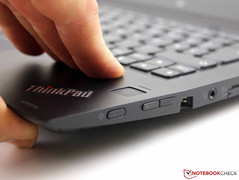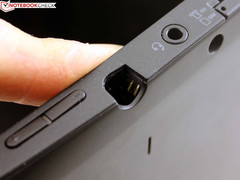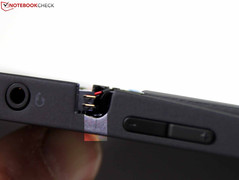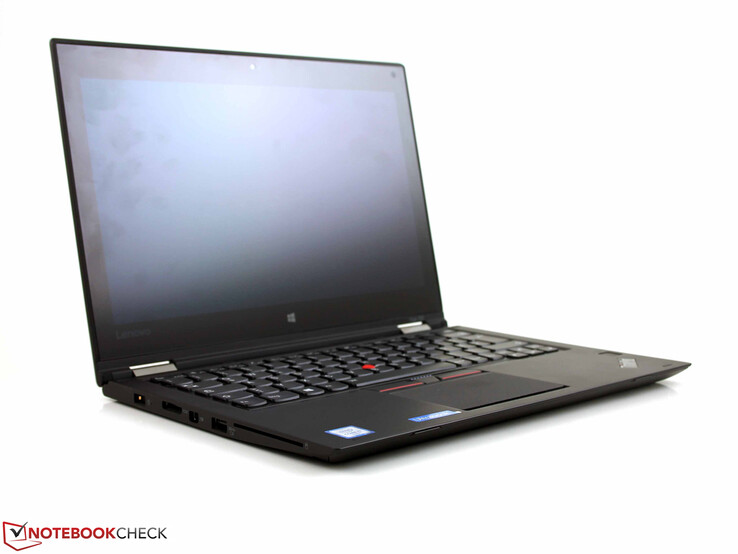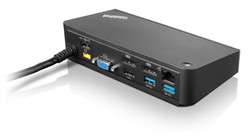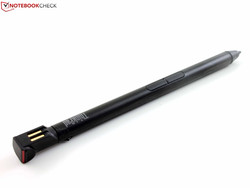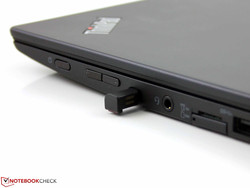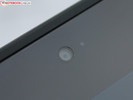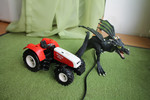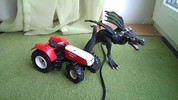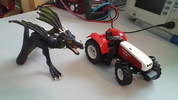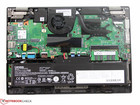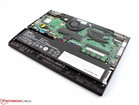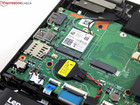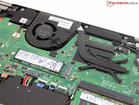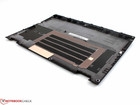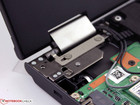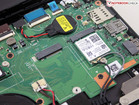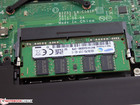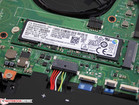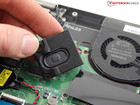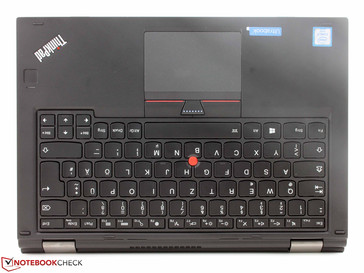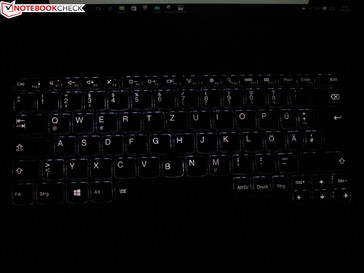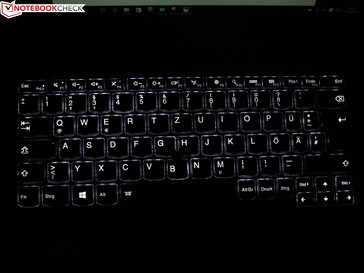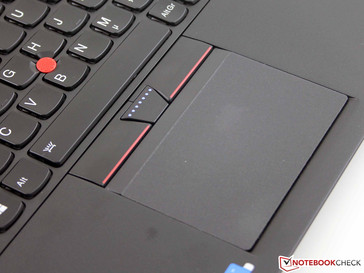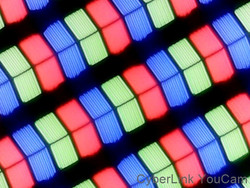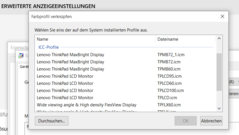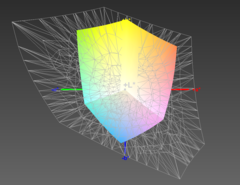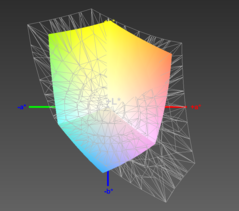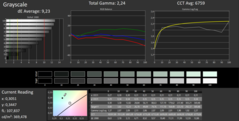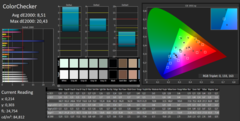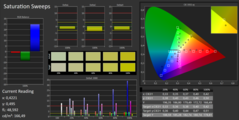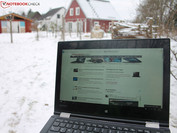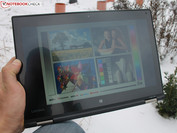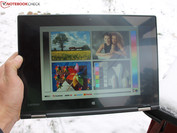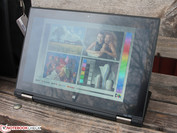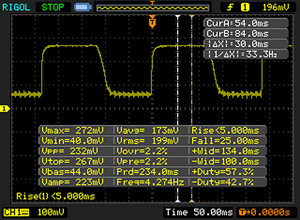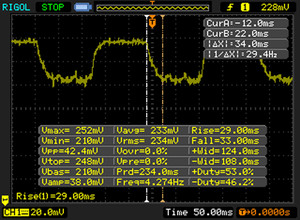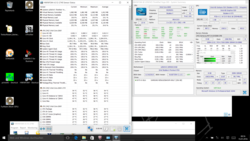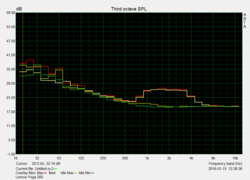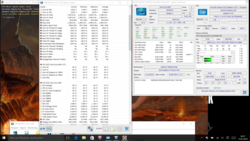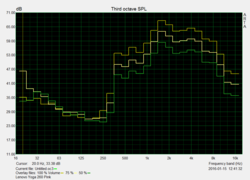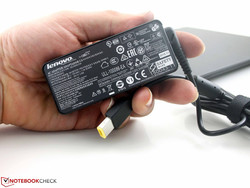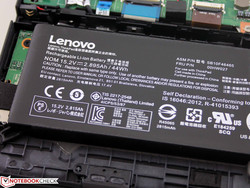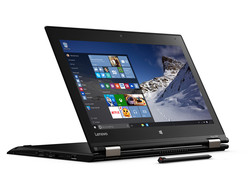Lenovo ThinkPad Yoga 260 20FD001XGE Convertible Review

For the original German review, see here.
Lenovo has a practical, 12-inch convertible in its lineup with the ThinkPad Yoga 260. Once again, it brings the multi-mode concept to the business sector. Can Lenovo's Yoga also impress fans of conventional clamshell subnotebooks? Examples would be the ThinkPad X250 and HP's EliteBook 820 G2 convertibles, also with matte Full HD screens but not a 360 degree hinge.
There are also the EliteBook Revolve 810 G3 (11.6 inches), Toshiba's Satellite Radius 12 and Lenovo's Yoga 3 Pro 13 (Core M-5Y51) that turn a small subnotebook into a tablet in the professional sector. Unfortunately, while the Revolve 810 G3 only offers an HD resolution, it is more expensive with a price tag of over 2000 Euros (~$2181). The Satellite Radius 12 is not quite as expensive; we are currently testing it and thus many rates are already in the database. Lenovo's Yoga 3 Pro 13 features remarkable, incredibly slim casing design. The tester did not like the keyboard in view of professional use quite as much. Users who want a docking solution might consider the 12-inch Toshiba Portege Z20t-B-10C tablet (Core M-5Y71), which is inserted in the keyboard unit.
Case
Lenovo delivers a high-quality construction that is plain yet highly pleasing with matte, firm surfaces. It is not uniformly robust; two hands can warp the base to some degree. The hinges are mounted very well in the base. No movement tugs at the plastic adversely. The hinges are pulled very tight, but they cannot prevent the slim lid from rocking. Thus, the display rocks more or less when touched by a finger (touch in laptop mode). The hinges can be rotated by 360 degrees. A mechanism lifts the keyboard grid and fixes the keys. The keyboard is disabled in tablet mode. The mechanism provides a haptic feature: The fixture makes the tablet's new underside more even and thus more pleasant to carry in the hands.
Unfortunately, the convenient stylus compartment on the left mars our impression. The stylus is inserted and recharged here. The opening creates a weak point that also tore right away in the review sample. That does not happen when picked up at a corner, but it can often happen when loading the chassis mechanically. We have marked the small tear in screenshot three.
We could visibly warp the lid. However, this flexibility is not annoying during use, especially since pressure marks are not produced at the edges. This did not happen when we applied selective pressure on the back, either.
Connectivity
Virtually all known interfaces with the exception of the USB Type C are installed. However, this new USB 3.0 cable version will probably need longer to establish itself in the business sector than in consumer devices. The docking port for Lenovo's OneLink+ Dock on the right and the SmartCard reader (banking, security critical applications) is interesting. Unfortunately, the manufacturer does not install a standard SD card reader, and only allows reading micro-SD cards. HDMI and mini-DisplayPort are not mutually exclusive; both are present.
Communication
Intel's Dual Band Wireless-AC 8260 including a Bluetooth 4.1 chip (without vPro) always ensured a reliable connection to the router in the test. It also functioned outstandingly outside the building; the connection did not break off at the 45 meter (~148 ft) measuring point (outdoors). Optionally, a Broadcom 802.11ac (2x2) with Bluetooth 4.1 Wi-Fi chip can be selected in Lenovo's store. This adds vPro, but then Intel's Wireless Display will no longer be available.
Although an RJ45 port is not installed due to the slim build, customers do not have to forgo cabled networks. Intel's I219-V Ethernet Connections is on board so that the Ethernet port in the docking station functions.
Security
The Yoga 260 is equipped with a Trusted Platform Module (dTPM), which contains a cryptographic key for uniquely identifying the computer. A SmartCard reader, fingerprint scanner and Kensington lock supplement the security in terms of hardware.
Accessories
In addition to the 45-watt power supply, a digital pen is included in the box and handwriting detection software is installed. The ThinkPad Pen Pro is the same size as a pen. Its 2048 pressure levels are to ensure accurate inputs. The WRITEit software turns handwriting in almost every text field into data input. For example, we could jot keywords directly in the browser URL bar and WRITEit converted them, providing word suggestions when illegible. The stylus is recharged automatically in its compartment in the tablet. It reaches a capacity of 80% within a few minutes for quick use; the rest needs much longer.
Docking Options
Native docking stations are still an important criterion for professional users. The USB 3.0 docks have not changed in the recent years. Usually they function well, but they have to convert all data, such as image, audio or Ethernet, into the USB protocol. This always requires a bit of performance on the fly, and thus manufacturer-specific docks that are docked to the hardware (without drivers) are still in fashion. Lenovo has favored the OneLink port for years. It is an extension of the power supply and corresponding docks are offered for it. This technology has also moved into parts of the budget class.
This is different in the current Yoga 260. It has a OneLink+ port separated from the power supply. A OneLink dock cannot be connected. It has to be the "ThinkPad OneLink+" docking station. It also supplies the laptop with power (dedicated 90-watt power supply). This docking station is a better choice than USB 3.0 solutions when using two external monitors. Users who do not need a docking station can use a single adapter; Lenovo has a VGA/RJ45 and mini-DP/VGA adapter in its lineup.
Warranty
Yoga 260 buyers can select from a set of different services. A two-year warranty (bring in) is included. The ThinkPlus ePac warranty upgrade to 3 years with battery replacement in case of defect costs 120 Euros (~$131). Users who need on-site repair in a worst case scenario can buy Lenovo's ePac On-Site repair. This service extension includes time and effort as well as spare parts with response on the next business day.
Webcam
Hardware
The base plate allows easy access to all components. The CPU is soldered and thus only elements such as LTE, Wi-Fi, RAM, fan, battery, and CMOS battery can be replaced. Accessing is impressively simple. However, a warning: The breaking point in the stylus holder is most vulnerable, particularly without the supportive base plate.
Input Devices
Keyboard
The keys' layout and technical qualities are similar to the ThinkPad X250 to the last detail. This is also true for the UltraNav unit composed of TrackPoint and touchpad. The chiclet keyboard is still splash proof. The ThinkPad characteristic of swapping the FN and Crtl keys (can be changed in BIOS) is found here again. The combination of firm pressure point, generous drop and high stability contributes to the input device's rich, mechanical typing feel. This is rarely found in other laptop lineups. The keys can be illuminated with white LEDs in two levels when desired.
ClickPad
The TrackPoint has three dedicated, gently triggering buttons. The touchpad (8.7 x 5.3 centimeters/~3.4 x 2.1 in) is installed as a fully integrated ClickPad. Lenovo's implementation stands out with a crisp and well-defined pressure point. However, some users will miss real keys. Of course, the TrackPoint's keys can be used together with the ClickPad. The pad does a good job and convinces with good gliding traits and finely adjusted multi-touch gestures.
Touchscreen
The manufacturer has applied an anti-glare layer to the touchscreen. It is naturally bubble-free and fitted absolutely impeccably. The surface feels pleasantly matte, but is still sleek enough to allow the finger to glide without stops. The surface is sensitive up to its edges. A finger can clearly move along the black bezel and the object is still moved. Inputs are implemented quickly, whether with one or several fingers, or with the ThinkPad Pen Pro. We quickly got used to handwriting detection. It is now finally possible to fill out every text field using the stylus without having to attach the keyboard in tablet mode.
Display
The screen size is 12.5 inches, and offers 1920x1080 pixels as a finger touchscreen. The panel with the model number N125HCE-GN1 (LEN40E6) is an IPS screen mounted on a 360 degree hinge. The resolution equates to 176 PPI. The pixel grid is still visible at a close distance. Lenovo is the only manufacturer besides Toshiba that sells touchscreens with anti-glare surfaces. However, this only applies to elite business devices like the ThinkPad X1 Carbon Touch. An IPS HD version with 1366x768 pixels is also offered in Lenovo's shop (touchscreen).
The brightness in the screen's center reaches almost 400 cd/m², but the average is "only" 335 cd/m² because the surrounding area is darker. The brightness differences are not great; we measured an illumination of 84%, which is in a good midfield. The rivals are also within a range of almost 400 cd/m².
| |||||||||||||||||||||||||
Brightness Distribution: 84 %
Center on Battery: 371 cd/m²
Contrast: 1279:1 (Black: 0.29 cd/m²)
ΔE ColorChecker Calman: 8.51 | ∀{0.5-29.43 Ø4.78}
ΔE Greyscale Calman: 9.23 | ∀{0.09-98 Ø5}
62% sRGB (Argyll 1.6.3 3D)
41% AdobeRGB 1998 (Argyll 1.6.3 3D)
44.55% AdobeRGB 1998 (Argyll 3D)
62.8% sRGB (Argyll 3D)
42.98% Display P3 (Argyll 3D)
Gamma: 2.24
CCT: 6759 K
| Lenovo ThinkPad Yoga 260 20FD001XGE IPS FHD non-glossy | HP Elitebook Revolve 810 G3 IPS HD glare | Lenovo Yoga 3 Pro IPS UHD glare | Toshiba Satellite Radius 12 P20W-C-106 IPS 4K glare | Toshiba Portege Z20t-B-10C IPS FHD non-glossy | |
|---|---|---|---|---|---|
| Display | 9% | 48% | -0% | ||
| Display P3 Coverage (%) | 42.98 | 46.85 9% | 63.6 48% | 42.63 -1% | |
| sRGB Coverage (%) | 62.8 | 69.1 10% | 94.7 51% | 63.6 1% | |
| AdobeRGB 1998 Coverage (%) | 44.55 | 48.42 9% | 65 46% | 44.1 -1% | |
| Response Times | -27% | ||||
| Response Time Grey 50% / Grey 80% * (ms) | 64 ? | 68 ? -6% | |||
| Response Time Black / White * (ms) | 30 ? | 44 ? -47% | |||
| PWM Frequency (Hz) | |||||
| Screen | 7% | -22% | 28% | -14% | |
| Brightness middle (cd/m²) | 371 | 322 -13% | 287 -23% | 388 5% | 342 -8% |
| Brightness (cd/m²) | 335 | 312 -7% | 280 -16% | 351 5% | 301 -10% |
| Brightness Distribution (%) | 84 | 87 4% | 88 5% | 85 1% | 76 -10% |
| Black Level * (cd/m²) | 0.29 | 0.32 -10% | 0.792 -173% | 0.32 -10% | 0.393 -36% |
| Contrast (:1) | 1279 | 1006 -21% | 362 -72% | 1213 -5% | 870 -32% |
| Colorchecker dE 2000 * | 8.51 | 5.19 39% | 3.08 64% | 1.83 78% | 9.69 -14% |
| Colorchecker dE 2000 max. * | 20.43 | ||||
| Greyscale dE 2000 * | 9.23 | 4.36 53% | 3.36 64% | 2.17 76% | 9.27 -0% |
| Gamma | 2.24 98% | 2.26 97% | 2.5 88% | 2.43 91% | 2.95 75% |
| CCT | 6759 96% | 5985 109% | 6087 107% | 6703 97% | 6010 108% |
| Color Space (Percent of AdobeRGB 1998) (%) | 41 | 44.3 8% | 60 46% | 40.4 -1% | |
| Color Space (Percent of sRGB) (%) | 62 | 95 53% | |||
| Total Average (Program / Settings) | 8% /
7% | -22% /
-22% | 16% /
24% | -7% /
-10% |
* ... smaller is better
Buyers looking for high color space coverage will not find it here. sRGB is covered by only 62%, no need to mention AdobeRGB. A color profile was not loaded on our Yoga 260 ex-factory, but the manufacturer has installed a selection of profiles for different applications. They can be loaded via Windows' tools; Lenovo does not have a convenient tool for this.
Although we did not discover a bluish tint, the CalMAN analysis (TFT without color profile) exhibits a light shift toward green. This is seen in the CalMAN Grayscale screenshot under Target/Actual. Consequently, the Grayscale DeltaE is 9, which is a relatively bad rate that is only surpassed by low-cost TN screens (DeltaE of 12 -15). However, more expensive rivals do not always do a better job. The Portégé Z20t-B-10C has DeltaE rates of 9 and 10. Calibration via a photospectrometer can reduce this inaccuracy slightly. The color profile linked in the box for the Yoga 260 FHD can also be used for this.
The brightness does not change in battery mode. It can be set to 371 cd/m² in the center, provided that the brightness sensor is disabled. That is situated in the display bezel's upper right corner. In conjunction with the AR-layer, we are faced with a Yoga 260 that is perfectly suitable for outdoor use.
Display Response Times
| ↔ Response Time Black to White | ||
|---|---|---|
| 30 ms ... rise ↗ and fall ↘ combined | ↗ 5 ms rise | |
| ↘ 25 ms fall | ||
| The screen shows slow response rates in our tests and will be unsatisfactory for gamers. In comparison, all tested devices range from 0.1 (minimum) to 240 (maximum) ms. » 79 % of all devices are better. This means that the measured response time is worse than the average of all tested devices (20.2 ms). | ||
| ↔ Response Time 50% Grey to 80% Grey | ||
| 64 ms ... rise ↗ and fall ↘ combined | ↗ 30 ms rise | |
| ↘ 34 ms fall | ||
| The screen shows slow response rates in our tests and will be unsatisfactory for gamers. In comparison, all tested devices range from 0.165 (minimum) to 636 (maximum) ms. » 97 % of all devices are better. This means that the measured response time is worse than the average of all tested devices (31.6 ms). | ||
Screen Flickering / PWM (Pulse-Width Modulation)
| Screen flickering / PWM not detected | ||
In comparison: 53 % of all tested devices do not use PWM to dim the display. If PWM was detected, an average of 8111 (minimum: 5 - maximum: 343500) Hz was measured. | ||
Performance
Lenovo offers its Yoga 260 with either Intel's Core i5-6200U (2x 2.30 GHz) or i7-6500U (2x 2.50 GHz) on the market. Buyers who order directly from Lenovo can also select an i3-6100U or i5-6300U processor. 8 GB of single-channel working memory is installed in the review sample. Lenovo offers a 4 GB DDR4-2133 SODIMM in its shop. The hard drive is a 256 GB SSD (SATA, M.2). Intel's HD Graphics 520 (iGPU) is part of the SoC.
Processor
Theoretically, the i7-6500U (2x 2.50 GHz) has a Turbo of 3.1 GHz, at least on one core. We did not come close to this clock rate in the tests. 2.2 to 2.3 GHz is achieved in both the Cinebench tests as well as during the Prime95 CPU stress test (multi). Thus, the computing performance quickly drops below the nominal clock in permanent load. The i7-6500U (Skylake) lags 9% behind its i7-5600U (Broadwell) predecessor in the R15 test. The single-core tests are roughly on par. This is also true for the R11.5 and R10 tests with minor deviations.
| Cinebench R10 | |
| Rendering Single CPUs 64Bit (sort by value) | |
| Lenovo Yoga 3 Pro | |
| Toshiba Portege Z20t-B-10C | |
| Rendering Multiple CPUs 64Bit (sort by value) | |
| Lenovo Yoga 3 Pro | |
| Toshiba Portege Z20t-B-10C | |
System Performance
The Yoga 260 is on par with HP's EliteBook Revolve 810 G3 based on the former i7-5600U SoC in the PCMarks. The Revolve even takes the lead in PCMark 7. The differences to the 15-watt systems can be negligible. However, clear losses in processing speed are noticed in Core M systems, such as Lenovo's Yoga 3 Pro that falls behind by 19% in PCMark 8. The also passively cooled Toshiba Portege Z20t-B-10C presents a very similar score here. It must be emphasized that Core M based rivals do not have a noticeably weaker performance. This device category should be sufficient, especially when the user is not focused on high-performance tools.
| PCMark 8 | |
| Home Score Accelerated v2 (sort by value) | |
| Lenovo ThinkPad Yoga 260 20FD001XGE | |
| HP Elitebook Revolve 810 G3 | |
| Lenovo Yoga 3 Pro | |
| Toshiba Portege Z20t-B-10C | |
| Creative Score Accelerated v2 (sort by value) | |
| Lenovo ThinkPad Yoga 260 20FD001XGE | |
| HP Elitebook Revolve 810 G3 | |
| Lenovo Yoga 3 Pro | |
| Toshiba Portege Z20t-B-10C | |
| Work Score Accelerated v2 (sort by value) | |
| Lenovo ThinkPad Yoga 260 20FD001XGE | |
| HP Elitebook Revolve 810 G3 | |
| Lenovo Yoga 3 Pro | |
| Toshiba Portege Z20t-B-10C | |
| Storage Score v2 (sort by value) | |
| Lenovo ThinkPad Yoga 260 20FD001XGE | |
| PCMark 7 Score | 5043 points | |
| PCMark 8 Home Score Accelerated v2 | 3263 points | |
| PCMark 8 Creative Score Accelerated v2 | 3952 points | |
| PCMark 8 Work Score Accelerated v2 | 4368 points | |
Help | ||
Storage Device
Samsung's PM871 SSD (256 GB) is among the top SSD speeds. It is on par with Samsung's PM851 SSD and Toshiba's HG6. There does not seem to be any significant differences here, as PCMark 7's System Storage also confirms.
| Lenovo ThinkPad Yoga 260 20FD001XGE HD Graphics 520, 6500U, Samsung SSD PM871 MZNLN256HCHP | HP Elitebook Revolve 810 G3 HD Graphics 5500, 5600U, Samsung SSD PM851 256 GB MZNTE256HMHP | Lenovo Yoga 3 Pro HD Graphics 5300, 5Y70, Samsung SSD PM851 256 GB MZNTE256HMHP | Toshiba Satellite Radius 12 P20W-C-106 HD Graphics 520, 6500U, Samsung SSD PM871 MZNLN256HCHP | Toshiba Portege Z20t-B-10C HD Graphics 5300, 5Y71, Toshiba HG6 THNSNJ256GVNU | |
|---|---|---|---|---|---|
| PCMark 7 | |||||
| System Storage (Points) | 5302 | 5222 -2% | 5263 -1% | 5430 2% | 5379 1% |
| CrystalDiskMark 3.0 | 7% | 10% | 10% | 15% | |
| Read Seq (MB/s) | 468.9 | 526 12% | 529 13% | 492.6 5% | 530 13% |
| Write Seq (MB/s) | 297.3 | 239.9 -19% | 242.1 -19% | 306.5 3% | 473.3 59% |
| Read 512 (MB/s) | 397.9 | 420.5 6% | 430.9 8% | 408.9 3% | 424.7 7% |
| Write 512 (MB/s) | 297.1 | 239.5 -19% | 242.4 -18% | 307.1 3% | 446.9 50% |
| Read 4k (MB/s) | 33.11 | 28.09 -15% | 35.95 9% | 33.48 1% | 22.91 -31% |
| Write 4k (MB/s) | 85.1 | 102.3 20% | 104.5 23% | 89.7 5% | 88.2 4% |
| Read 4k QD32 (MB/s) | 398.3 | 389.8 -2% | 339.8 -15% | 323.9 -19% | 295.6 -26% |
| Write 4k QD32 (MB/s) | 136.6 | 238.4 75% | 240.6 76% | 249 82% | 197.3 44% |
| AS SSD | -3% | -10% | 3% | ||
| Seq Read (MB/s) | 482.3 | 511 6% | 482.4 0% | 513 6% | |
| Seq Write (MB/s) | 282.9 | 249.1 -12% | 229.1 -19% | 457.2 62% | |
| 4K Read (MB/s) | 29.07 | 26.91 -7% | 27.14 -7% | 21.4 -26% | |
| 4K Write (MB/s) | 70 | 90.3 29% | 61.3 -12% | 76.8 10% | |
| Score Read (Points) | 448 | 416 -7% | 433 -3% | 428 -4% | |
| Score Write (Points) | 361 | 299 -17% | 283 -22% | 305 -16% | |
| Score Total (Points) | 1037 | 924 -11% | 934 -10% | 954 -8% | |
| Total Average (Program / Settings) | 1% /
2% | -0% /
0% | 6% /
9% | 6% /
9% |
Graphics Card
The HD Graphics 520 only uses single-channel RAM, which is also noticed. The 520 GPU should be measurably faster than the Broadwell HD 5500. It is however on par in the Yoga 260. That cannot be related to the clock rates; 850 to 1000 MHz is reached in the GPU tests. Thus, the reason can only be the single-channel memory. This cannot be remedied by installing a second module since the Yoga 260 only has one RAM bank.
The video decoder integrated in the iGPU is meant as support, but not for computing-driven GPU applications. However, it should be considered that the performance of the HD Graphics has consistently improved in the recent years, and it has now achieved the performance of small dedicated solutions, e.g. GeForce 920M, in some cases. Therefore, the topic of gaming is rather a negligible issue. Only very undemanding games will run smoothly in high details.
| 3DMark - 1280x720 Cloud Gate Standard Score (sort by value) | |
| Lenovo ThinkPad Yoga 260 20FD001XGE | |
| HP Elitebook Revolve 810 G3 | |
| Lenovo Yoga 3 Pro | |
| Toshiba Satellite Radius 12 P20W-C-106 | |
| Toshiba Portege Z20t-B-10C | |
| 3DMark 11 - 1280x720 Performance (sort by value) | |
| Lenovo ThinkPad Yoga 260 20FD001XGE | |
| HP Elitebook Revolve 810 G3 | |
| Lenovo Yoga 3 Pro | |
| Toshiba Satellite Radius 12 P20W-C-106 | |
| Toshiba Portege Z20t-B-10C | |
| 3DMark 11 Performance | 1333 points | |
| 3DMark Ice Storm Standard Score | 46556 points | |
| 3DMark Cloud Gate Standard Score | 5299 points | |
| 3DMark Fire Strike Score | 721 points | |
Help | ||
| Crysis 3 - 1024x768 Low Preset (sort by value) | |
| Lenovo ThinkPad Yoga 260 20FD001XGE | |
| Lenovo Yoga 3 Pro | |
| Fifa 15 - 1366x768 High Preset AA:2x MS (sort by value) | |
| Lenovo ThinkPad Yoga 260 20FD001XGE | |
| Lenovo Yoga 3 Pro | |
| Battlefield Hardline - 1024x768 Low Graphics Quality (DX11) (sort by value) | |
| Lenovo ThinkPad Yoga 260 20FD001XGE | |
| Toshiba Satellite Radius 12 P20W-C-106 | |
| low | med. | high | ultra | |
|---|---|---|---|---|
| Crysis 3 (2013) | 20.4 | 13.5 | ||
| Fifa 15 (2014) | 35.6 | 21.3 | ||
| Battlefield Hardline (2015) | 36.2 | 27.9 | 10.1 |
Emissions
System Noise
The Yoga 260 is a rather quiet device. The active cooling remains disabled most of the time while idling. The noise level is approximately low 36 dB(A) during load no matter if via stress test, processor benchmark or 3DMark. This is proportionately little for comparable devices with active cooling. Lenovo's Yoga 3 Pro is a hybrid in this regard - although it is based on a Core M, it has a fan.
| Lenovo ThinkPad Yoga 260 20FD001XGE HD Graphics 520, 6500U, Samsung SSD PM871 MZNLN256HCHP | HP Elitebook Revolve 810 G3 HD Graphics 5500, 5600U, Samsung SSD PM851 256 GB MZNTE256HMHP | Lenovo Yoga 3 Pro HD Graphics 5300, 5Y70, Samsung SSD PM851 256 GB MZNTE256HMHP | Toshiba Satellite Radius 12 P20W-C-106 HD Graphics 520, 6500U, Samsung SSD PM871 MZNLN256HCHP | |
|---|---|---|---|---|
| Noise | 5% | 9% | -7% | |
| Idle Minimum * (dB) | 31.5 | 29.1 8% | 28.9 8% | 32.5 -3% |
| Idle Average * (dB) | 31.5 | 29.1 8% | 30.1 4% | 32.6 -3% |
| Idle Maximum * (dB) | 32 | 29.1 9% | 30.1 6% | 32.6 -2% |
| Load Average * (dB) | 36.4 | 35.6 2% | 31.5 13% | 41 -13% |
| Load Maximum * (dB) | 36.6 | 37.2 -2% | 31.9 13% | 41 -12% |
| off / environment * (dB) | 31.3 |
* ... smaller is better
Noise level
| Idle |
| 31.5 / 31.5 / 32 dB(A) |
| Load |
| 36.4 / 36.6 dB(A) |
 | ||
30 dB silent 40 dB(A) audible 50 dB(A) loud |
||
min: | ||
Temperature
The stress test continues what the above CPU benchmarks had already indicated: High thermal load causes the processor clock rate to throttle significantly. Load from the iGPU is added in the stress test, and the clock drops even further to 1.4 GHz. The iGPU is favored, i.e. although it does not fully utilize its full potential at just 850 MHz, it still comes close to its maximum. The clock recovers its normal level of 2.3 GHz within 5 seconds after the GPU part of the stress test is stopped, which is the same as in the CPU tests.
The waste heat produced on the surfaces in the stress test - see chart - are of course not applicable to routine use. They represent the top rates in a negative sense. Thus, users can potentially expect at most 43 degrees Celsius (~109 degrees Fahrenheit) in individual areas during load. The average is only 32 degrees Celsius (~90 degrees Fahrenheit). The Yoga 260 always remains acceptably cool. Unfortunately, we also know why: It is due to the CPU clock rate's massive throttling in the extreme stress test (1.4 GHz) as well as during simple CPU load (2.2 to 2.3 GHz). The casing only heats up slightly while idling despite the mostly inactive fan. We only measured 25 degrees Celsius (~77 degrees Fahrenheit) in selective areas at a room temperature of 22 degrees Celsius (average: 24 degrees Celsius/~72 degrees Fahrenheit; average 75 degrees Fahrenheit). These temperatures are virtually unnoticeable.
| Lenovo ThinkPad Yoga 260 20FD001XGE HD Graphics 520, 6500U, Samsung SSD PM871 MZNLN256HCHP | HP Elitebook Revolve 810 G3 HD Graphics 5500, 5600U, Samsung SSD PM851 256 GB MZNTE256HMHP | Lenovo Yoga 3 Pro HD Graphics 5300, 5Y70, Samsung SSD PM851 256 GB MZNTE256HMHP | Toshiba Satellite Radius 12 P20W-C-106 HD Graphics 520, 6500U, Samsung SSD PM871 MZNLN256HCHP | Toshiba Portege Z20t-B-10C HD Graphics 5300, 5Y71, Toshiba HG6 THNSNJ256GVNU | |
|---|---|---|---|---|---|
| Heat | -4% | -12% | -9% | -10% | |
| Maximum Upper Side * (°C) | 42.6 | 39.9 6% | 42.1 1% | 46.5 -9% | 48.3 -13% |
| Maximum Bottom * (°C) | 42.6 | 39.5 7% | 37 13% | 43 -1% | 43.2 -1% |
| Idle Upper Side * (°C) | 25.1 | 28.4 -13% | 34.4 -37% | 28.9 -15% | 28.9 -15% |
| Idle Bottom * (°C) | 25.3 | 28.8 -14% | 31.7 -25% | 28.4 -12% | 27.7 -9% |
* ... smaller is better
(±) The maximum temperature on the upper side is 42.6 °C / 109 F, compared to the average of 35.4 °C / 96 F, ranging from 19.6 to 60 °C for the class Convertible.
(±) The bottom heats up to a maximum of 42.6 °C / 109 F, compared to the average of 36.8 °C / 98 F
(+) In idle usage, the average temperature for the upper side is 24.2 °C / 76 F, compared to the device average of 30.3 °C / 87 F.
(+) The palmrests and touchpad are cooler than skin temperature with a maximum of 29.5 °C / 85.1 F and are therefore cool to the touch.
(±) The average temperature of the palmrest area of similar devices was 27.9 °C / 82.2 F (-1.6 °C / -2.9 F).
Speakers
The speakers are situated above the keyboard with their opening toward the display. This reflects the sound waves slightly toward the user. The little speakers are not particularly strong. Mids are emphasized, but trebles and low-pitches are neglected. The sound is sufficient for background music while typing. Speech is very intelligible. At least the little membranes do not scratch at maximum volume. The pink noise at the side shows that only half the frequency bandwidth is rendered. This is typical for basic speakers in little laptops. Speech and music are sufficiently covered, but any differentiation beyond that goes by the boards. This results in a thin, vague sound impression (compared with stereo speakers, subwoofer laptops).
The microphone only does a satisfactory job. Unfortunately, the recorder in conjunction with the stereo microphone beside the webcam does not record static-free. A base noise not only remains, but the voice also clangs and it sometimes records a muffled distortion of speech no matter at what distance the user speaks. The distortions decrease the closer the speaker is to the laptop and the more he speaks directly into the microphone. Lenovo states a dual-digital array microphone with VoIP optimization. We find its outcome less than ideal.
Energy Management
Power Consumption
The 45-watt power supply always provides enough energy. The charger needs only two hours for fully recharging the Yoga 260's 44 Wh battery when idling. The power consumption is very low. 23 watts during peak load is very little for a 15-watt Skylake system. That would be exemplary if we did not know that throttling leads to a lower stress test power consumption than temporary normal load.
| Lenovo ThinkPad Yoga 260 20FD001XGE HD Graphics 520, 6500U, Samsung SSD PM871 MZNLN256HCHP | HP Elitebook Revolve 810 G3 HD Graphics 5500, 5600U, Samsung SSD PM851 256 GB MZNTE256HMHP | Lenovo Yoga 3 Pro HD Graphics 5300, 5Y70, Samsung SSD PM851 256 GB MZNTE256HMHP | Toshiba Satellite Radius 12 P20W-C-106 HD Graphics 520, 6500U, Samsung SSD PM871 MZNLN256HCHP | Toshiba Portege Z20t-B-10C HD Graphics 5300, 5Y71, Toshiba HG6 THNSNJ256GVNU | |
|---|---|---|---|---|---|
| Power Consumption | 5% | -10% | -88% | 19% | |
| Idle Minimum * (Watt) | 3.6 | 2.1 42% | 3.7 -3% | 8.8 -144% | 2.4 33% |
| Idle Average * (Watt) | 6.3 | 4 37% | 8.9 -41% | 12.8 -103% | 4.6 27% |
| Idle Maximum * (Watt) | 7.6 | 5.4 29% | 10.7 -41% | 13.7 -80% | 5.6 26% |
| Load Average * (Watt) | 27.2 | 27.1 -0% | 22 19% | 38 -40% | 15.6 43% |
| Load Maximum * (Watt) | 22.8 | 41.5 -82% | 19.5 14% | 39 -71% | 30.7 -35% |
* ... smaller is better
| Off / Standby | |
| Idle | |
| Load |
|
Key:
min: | |
Battery Runtime
The battery life of almost six hours is useful, but not extraordinary. The EliteBook Revolve 810 G3 achieves 44% more with the same capacity in the Wi-Fi test (2:30 hours longer!). The idle power consumption does not look quite as bad. In relation to almost 16 hours (idle) and almost 6 hours (Wi-Fi), almost seven hours might be possible. Lenovo states up to 10 hours of runtime (MobileMark 2007, estimated maximum rate), but we cannot confirm that. Toshiba's Portégé Z20t steps out of line with its 72 Wh battery. The Core M easily achieves almost 13 hours in the Wi-Fi test with this lavish reserve.
| Lenovo ThinkPad Yoga 260 20FD001XGE 44 Wh 6500U | HP Elitebook Revolve 810 G3 44 Wh 5600U | Lenovo Yoga 3 Pro 44 Wh M-5Y70 | Toshiba Satellite Radius 12 P20W-C-106 42 Wh 6500U | Toshiba Portege Z20t-B-10C 72 Wh M-5Y71 | Dell Latitude 13 7350 50 Wh M-5Y10 | |
|---|---|---|---|---|---|---|
| Battery runtime | 29% | 21% | -31% | 159% | 104% | |
| Reader / Idle (h) | 15.7 | 18.4 17% | 10.6 -32% | 26.9 71% | 15.9 1% | |
| WiFi v1.3 (h) | 5.8 | 8.3 43% | 4 -31% | 12.7 119% | ||
| Load (h) | 1.5 | 1.9 27% | 2.6 73% | 5.8 287% | 4.6 207% | |
| H.264 (h) | 7.1 | 6.3 | 13.1 | 7.9 | ||
| WiFi (h) | 6.3 | 8.7 |
Pros
Cons
Verdict
The smallest version of the Yoga 260 already costs 1131 Euros (~$1234) in Lenovo's shop. It comes with an IPS HD panel (touch, matte), a Core i3 and a 128 GB SSD. The review sample is priced at 1480 Euros (~$1614) with higher configurations (16 GB RAM, 512 GB SSD) available. A device has to offer more than just the aura of legendary ThinkPad subnotebooks to justify these prices.
The Yoga 260 accepts the challenge and follows in the footsteps of Lenovo's ThinkPad X250 Ultrabook. The input devices are adopted 1:1, which is very positive. The rest of the 360 degree convertible's aura is a completely different one than that of the classic ThinkPad X250. Converting a laptop into a tablet is undoubtedly avant-garde in a meeting. The same is true for Tent Mode that allows making lovely presentations. However, the Yoga 260 becomes unique with its combination of matte touchscreen and stylus with pressure levels. Fill out a Web form via stylus, make side notes - the modern ThinkPad user can now do that productively.
Only the mediocre battery life restricts productivity somewhat. At least the battery is recharged fully within two hours. We like the bright, matte touchscreen. Besides that, the OneLink+ docking port adds multiple ports externally without needing the USB protocol and it even recharges the Yoga 260. The multiple configurations of low-end (i3, 4 GB, HD panel) up to high-end (i7, 512 GB, FHD panel) are typical business. The optional LTE module (M.2 not in review sample) and SIM card slot enable mobile data connections independent of a smartphone. Low emissions round off the package of a practical and light convertible.
There does not seem much to complain about. But then why is the rating "only" in the upper Good section (86%)? The Yoga 260 cannot outclass the "quasi-predecessor" ThinkPad X250 (87%) despite its multiple modes. We mostly disliked the breaking point in the bezel. As nice as it is to store and recharge the stylus here, the designers should have thought about a potential risk of breakage. The TFT's color reproduction is quite weak, but that can be remedied if not eliminated via calibration or using the installed color profiles. And then there is the issue of CPU throttling during just normal load. Why should the fastest 15-watt i7 be purchased if it cannot deliver what it promises?
In our opinion, HP's EliteBook Revolve 810 G3 with better runtimes and also very good input devices is a lucrative rival. It also has a docking port and LTE modem, but the very good IPS TFT only has an outdated HD resolution of 1366x768 pixels. The price of 2000 Euros (~$2181) is good but somewhat exaggerated. Then we would prefer the Portégé Z20t-B with a Full HD panel (AR coated!). The tablet with docking keyboard also costs 2000 Euros (~$2181).
Thus, Lenovo's Yoga 3 Pro (starts at 1100 Euros/~$1200) remains to be our favorite among the rivals in terms of price. It has a resolution of 3200x1800 pixels, but is glossy. It also lacks some business options, such as upgrade possibilities, docking and security. We have not finished testing Toshiba's Satellite Radius 12 P20W-C, but we can already say: The Radius 12 is a high-quality device with decent input devices that, however, lacks relevant professional features (maintenance, connectivity, security).
It is ultimately not a question of choice: The buyer or company either has 2000 Euros (~$2181) at their disposal, which would make the EliteBook Revolve 810 G3 or Portégé Z20t-B the matching device (almost) without compromise, or the Yoga 260 is a good choice when "only" 1000 to 1500 Euros (~$1090 to ~$1636) are in the budget. Its entry-level configuration is relatively affordable and features professional business qualities that HP and Fujitsu provide at approximately 2000 Euros (~$2181). Dell's Latitude 13 7350 with a Core M-5Y10 and FHD touchscreen for around 1400 Euros (~$1527) should not be forgotten. The long battery life of 8:42 hours (Wi-Fi test) is complemented by very good input devices, a superb FHD panel and a maintenance hatch. However, the device's stability is a shortcoming just like the comparatively weak computing performance.
Lenovo ThinkPad Yoga 260 20FD001XGE
- 04/18/2016 v5.1 (old)
Sebastian Jentsch




